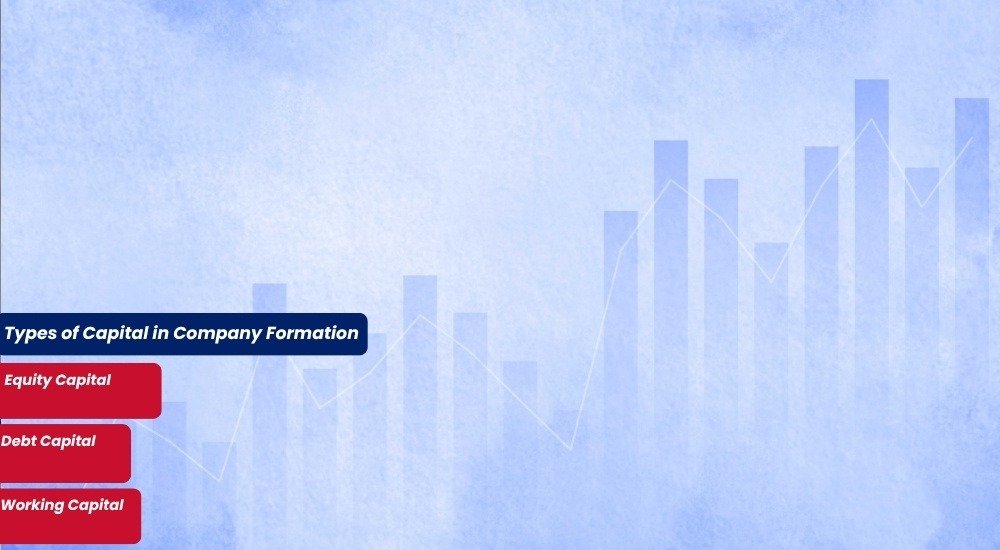When forming a company, one of the most crucial aspects to consider is capital. Capital is the financial foundation of any business, enabling it to operate, grow, and sustain itself.
Without adequate capital, a company cannot purchase assets, hire employees, or even conduct its core business. Understanding the different types of capital involved in company formation is essential for entrepreneurs, investors, and legal professionals.
In this article, we will examine capital, its significance, and the various types of capital in the context of company formation. This understanding will help clarify the legal and financial structure that businesses must work with when setting up and running a company.
What Is Capital in Company Formation?
In simple terms, capital refers to the funds a Company invests in its operations and growth.
It serves as the company’s financial backbone, supporting various business activities, including purchasing equipment, paying employees, and meeting liabilities.
In the Companies Act 2063, Capital is defined as the total amount of money or other assets used to fund the business.
This includes both the owners’ contributions (equity capital) and borrowed funds (debt capital).
When a company is formed, capital is raised from various sources, depending on the business structure, the number of investors, and the scale of operations.
Capital is usually divided into shares, and the value of a share represents the ownership stake of investors or shareholders in the company.
The Importance of Capital in Company Formation
Capital plays an integral role in the formation and operation of a company. Here are some key reasons why capital is important:
- Business Setup – Capital is required to set up a company, including paying for registration fees, office space, equipment and initial operational costs.
- Operational Costs – Companies need capital to finance daily operations, including paying wages, purchasing inventory, and covering utility bills.
- Expansion and Growth – A company with sufficient capital can expand its operations, invest in marketing, acquire new assets, and hire more employees to support growth.
- Credibility – The amount of capital a company raises can impact its reputation and credibility in the market. A well-capitalised company is often seen as more stable and reliable.
- Risk Management – Adequate capital helps manage risks by ensuring that the company can withstand financial setbacks and continue operations without immediate financial distress.
Types of Capital in Company Formation
Companies utilise various types of capital in their formation and operations.
These can be broadly classified into equity capital, debt capital, and working capital, but each of these categories can be broken down further into specific types:
Equity Capital
Equity capital refers to the money a company raises by issuing shares or other forms of ownership.
Shareholders, who invest their funds in the company, become partial owners and have a claim on the company’s profits, as well as a say in its management through voting rights at shareholder meetings.
Here are further classifications of equity capital:
- Authorised Capital – This is the maximum amount of capital a company can raise through the issuance of shares, as specified in its Memorandum of Association. The authorised capital sets an upper limit on the number of shares a company can issue to investors.
- Issued Capital - This refers to the portion of the authorised capital that the company has actually offered to shareholders. Not all authorised capital needs to be issued. A company may issue a portion of its shares to meet its funding requirements.
- Subscribed Capital - Subscribed capital is the amount of capital that shareholders have agreed to contribute by purchasing the shares. This amount may be paid in full or in part.
- Paid-up Capital - Paid-up capital is the actual amount of money that shareholders have paid for the shares they have subscribed to. This amount may differ from the subscribed capital, as it represents the funds actually received by the company.
- Call-Up Capital - This refers to the portion of subscribed capital that is not paid immediately but can be called upon by the company when needed. Shareholders are required to pay this amount when the company calls for it, typically to address financial needs.
- Preference Capital - This type of equity capital refers to the shares that give shareholders a preferential right to dividends before ordinary shareholders. However, these shareholders do not usually have voting rights.

Debt Capital
Debt capital is the money that a company borrows from external sources and must repay with interest.
The company does not own debt capital, instead, it represents obligations that must be paid back under the agreed terms.
Furthermore, the debt capital is divided into several types, which are mentioned below:
- Long-Term Debt – This is debt with a repayment period that exceeds one year. Long-term debt is usually secured through assets or guarantees. It can come in the form of bonds, debentures, or long-term loans.
- Short-Term Debt – This debt is due within one year. It is typically used to finance a business’s day-to-day operations. Short-term debt includes overdrafts, trade credits, and short-term loans.
- Secured Debt – This type of debt is backed by collateral. If the company fails to repay the debt, the lender can claim the collateral to recover their funds.
- Unsecured Debt – Unsecured debt does not require collateral. Since lenders face greater risk, the interest rates on unsecured debt tend to be higher than those on secured debt.
- Convertible Debt – Convertible debt is a type of debt that can be converted into equity at a later stage, often at the discretion of the debt holder. It provides companies with an additional financing option without requiring immediate dilution of shareholders’ equity.
Working Capital
Working capital is required to finance a business’s day-to-day operations.
It is calculated as the difference between a company’s current assets (such as cash, inventory, and receivables) and its current liabilities (such as short-term debts and accounts payable).
Here are the divisions of working capital:
- Permanent Working Capital – This is the minimum amount of capital needed to keep the company operating continuously.
- Variable Working Capital – This type of capital fluctuates based on business activity. For example, a company may need additional working capital during peak seasons or when launching new products.
Other Types of Capital in Company Formation
Apart from the major categories discussed above, there are other specialised forms of capital that businesses may encounter during their formation and operation:
1. Venture Capital
Venture capital is funding provided by investors to early-stage companies with high growth potential.
Venture capitalists take a significant risk in exchange for equity in the business. This type of capital is often sought by startups and tech companies that need substantial funding to scale their operations.
2. Seed Capital
Seed capital refers to the initial funding that entrepreneurs use to start a business.
This is typically used for market research, business planning, and the development of prototypes.
Seed capital can come from personal savings, angel investors, or family and friends.
3. Working Capital Loan
A working capital loan is a short-term loan that helps companies meet day-to-day operational expenses.
Unlike other types of loans, working capital loans are not used to purchase long-term assets; instead, they are intended for temporary funding needs.
Conclusion
Understanding capital and its different types is crucial when forming a company.
Equity capital enables businesses to raise funds by selling ownership stakes to investors, while debt capital allows companies to borrow funds and repay them with interest.
Working capital ensures that the company can finance its day-to-day operations.
In Nepal, company law, MOA and AOA provide the legal framework for raising and managing these types of capital.
Entrepreneurs must carefully choose the appropriate type of capital based on their company’s needs, growth prospects, and the level of risk they are willing to undertake.
By selecting the right mix of capital, companies can ensure their long-term success, financial stability, and growth in an increasingly competitive market.





